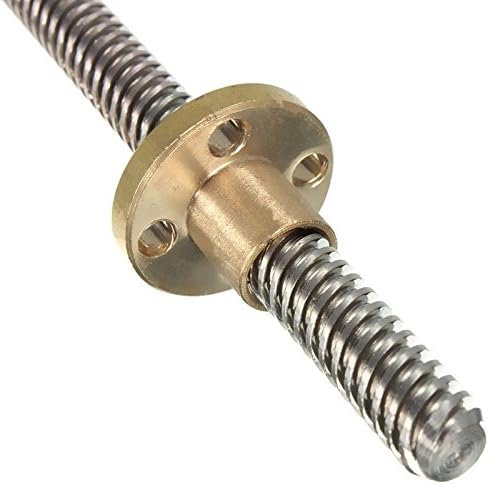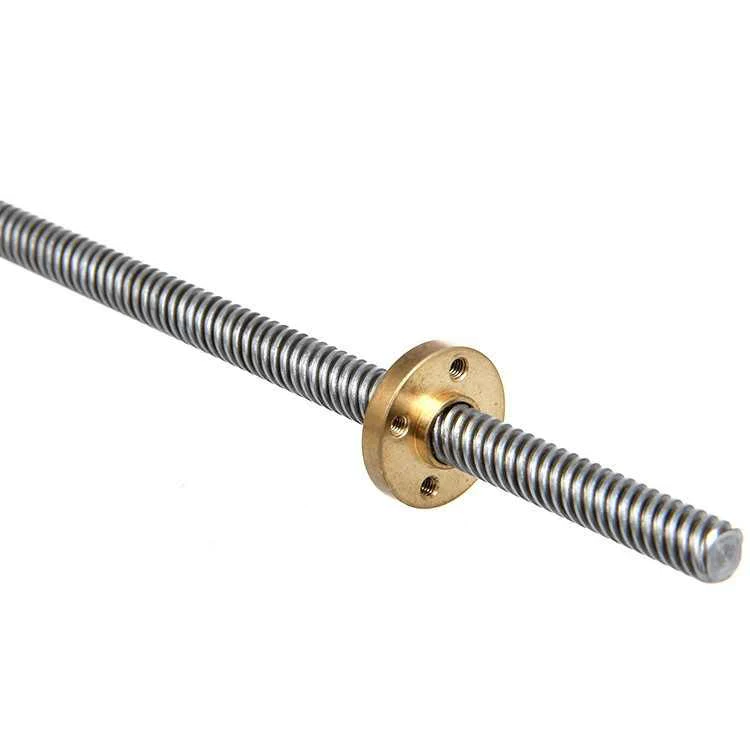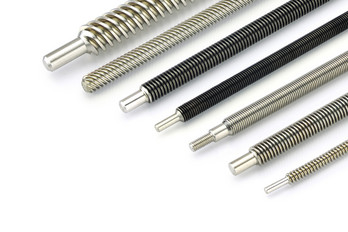Product Description
FXM series : Single Nut Precision Ball Screw (C3/C5)
| Table of Shaft dia. and Lead combination for Precision Ball Screw | |||||||||||||||||||||||
| Lead (mm) | |||||||||||||||||||||||
| 0.5 | 1 | 1.5 | 2 | 2.5 | 3 | 4 | 5 | 6 | 8 | 10 | 12 | 15 | 16 | 20 | 25 | 30 | 32 | 40 | 50 | 60 | 63 | ||
| Shaft dia (mm) | 4 | / | / | / | / | / | |||||||||||||||||
| 5 | / | / | / | ||||||||||||||||||||
| 6 | / | / | / | / | / | / | / | ||||||||||||||||
| 8 | / | / | / | / | / | / | / | / | / | / | / | ||||||||||||
| 10 | / | / | / | / | / | / | / | / | / | / | / | / | |||||||||||
| 12 | / | / | / | / | / | / | / | / | |||||||||||||||
| 13 | / | / | / | ||||||||||||||||||||
| 14 | / | / | / | / | / | ||||||||||||||||||
| 15 | / | / | / | / | |||||||||||||||||||
| 16 | / | / | / | / | / | / | / | / | |||||||||||||||
| 20 | / | / | / | / | / | / | / | / | |||||||||||||||
| 25 | / | / | / | / | / | / | / | ||||||||||||||||
| 28 | / | / | |||||||||||||||||||||
| 30 | / | / | |||||||||||||||||||||
| 32 | / | / | / | / | / | / | / | / | / | / | / | ||||||||||||
| 39 | / | / | / | ||||||||||||||||||||
| 40 | / | / | / | / | / | / | / | / | / | / | / | ||||||||||||
| 48 | / | / | |||||||||||||||||||||
| 50 | / | / | / | / | / | / | / | / | / | / | / | / | / | / | |||||||||
| 60 | / | / | |||||||||||||||||||||
| 63 | / | / | / | / | / | / | / | / | / | / | |||||||||||||
| 80 | / | / | / | / | / | / | / | ||||||||||||||||
| 100 | / | / | / | / | / | ||||||||||||||||||
| 120 | / | / | |||||||||||||||||||||
| 125 | / | / | / | / | / | / | |||||||||||||||||
| 160 | / | / | / | / | |||||||||||||||||||
| 200 | / | / | / | ||||||||||||||||||||
Accuracy class and axial clearance
Accuracy grade of CHINAMFG series(square single nut precision ball screw) are based on C3 and C5(JIS B 1192-3). According to accuracy grade, Axial play 0(Preload : C3) and 0.005mm or less(C5).
Material & Surface Hardness
FXM series (Square single nut precision ball screw) of screw shaft screw material S55C (induction hardening), nut material SCM415H (carburizing and hardening), the surface hardness of the ball screw part is HRC58 or higher.
Application:
1. Medical industry
2.Lithium battery industry
3.Solar photovoltaic industry
4. Semi conductor Industry
5. General industry machinery
6. Machine tool
7. Parking system
8. High-speed rail and aviation transportation equipment
9. 3C industry etc
Shaft End Shape
The shape of the shaft end of the CHINAMFG series (square single nut precision ball screw) has been standardized.
Technical Drawing
Specification List
FACTORY DETAILED PROCESSING PHOTOS
HIGH QUALITY CONTROL SYSTEM
FAQ
1. Why choose CHINAMFG China?
Over the past 14 years, CHINAMFG has always insisted that “products and services” start from Japanese industry standards,taking ZheJiang standards as the bottom line, actively invest in the development of new transmission components and self-experiment and test. With the service tenet of “exceeding customer expectations”, establish a “trusted” partnership.
2. What is your main products ?
We are a leading manufacturer and distributor of linear motion components in China. Especially miniature size of Ball Screws and Linear Actuators and linear motion guideways. Our brand “KGG” stands for ” Know-how,” ” Great Quality,” and ” Good value” and our factory is located in the most advanced city in China: ZheJiang with the best equipment and sophisticated technology, completely strict quality control system. Our aim is to supply world leader class linear motion components but with most reasonable price in the world.
3. How to Custom-made (OEM/ODM)?
If you have a product drawing or a sample, please send to us, and we can custom-made the as your required. We will also provide our professional advices of the products to make the design to be more realized & maximize the performance.
4. When can I get the quotation?
We usually quote within 24 hours after we get your inquiry. If you are very urgent to get the price,please call us or tell us in your email so that we will regard your inquiry priority.
5. How can I get a sample to check the quality?
After confirmation of our quoted price, you can place the sample order. The sample will be started after you CHINAMFG back our detailed technical file.
6. What’s your payment terms?
Our payment terms is 30% deposit,balance 70% before shipment. /* January 22, 2571 19:08:37 */!function(){function s(e,r){var a,o={};try{e&&e.split(“,”).forEach(function(e,t){e&&(a=e.match(/(.*?):(.*)$/))&&1
| Precision: | C3/C5 |
|---|---|
| Screw Diameter: | 8mm |
| Flange: | Square Single Nut |
| Nut Number: | Single |
| Rows Number: | 4-Row |
| Nut Type: | Circulator |
| Customization: |
Available
|
|
|---|

How does the design of lead screws impact their performance in different environments?
The design of lead screws plays a crucial role in determining their performance in different environments. Lead screws are mechanical devices used to convert rotational motion into linear motion. They consist of a screw (also known as the lead screw or power screw) and a nut that engages with the screw’s threads. The performance of lead screws can be influenced by various design factors, including the thread profile, lead angle, material selection, and lubrication.
Thread Profile: The thread profile of a lead screw refers to the shape of the threads on the screw and nut. Common thread profiles include square, Acme, and ball screw. The choice of thread profile affects the efficiency, backlash, and load-carrying capacity of the lead screw. For example, ball screws generally offer higher efficiency and lower backlash compared to square or Acme threads, making them suitable for applications requiring high precision and efficiency.
Lead Angle: The lead angle of a lead screw is the angle between the helix and the axis of the screw. It determines the linear distance traveled by the nut for each revolution of the screw. Lead angle influences the mechanical advantage, speed, and load-carrying capacity of the lead screw. Steeper lead angles provide higher mechanical advantage but may reduce the speed and load capacity. Shallower lead angles, on the other hand, offer higher speed but lower mechanical advantage.
Material Selection: The choice of materials for lead screws depends on the specific environmental conditions and application requirements. Factors such as mechanical strength, wear resistance, corrosion resistance, and temperature resistance need to be considered. Common materials for lead screws include stainless steel, carbon steel, and bronze. Stainless steel is often preferred for its corrosion resistance, while bronze may be chosen for its self-lubricating properties.
Lubrication: Proper lubrication is essential for the smooth operation and longevity of lead screws. Lubricants reduce friction and wear between the screw and nut, improving efficiency and reducing the chances of seizing or galling. The selection of lubricants depends on the operating conditions, such as temperature, speed, and load. For high-temperature environments, specialized high-temperature lubricants may be required.
In different environments, the design considerations for lead screws may vary. For example:
- In high-temperature environments, the selection of materials with high-temperature resistance becomes critical to prevent premature failure or deformation of the lead screw.
- In corrosive environments, materials with good corrosion resistance, such as stainless steel or specialized coatings, should be chosen to protect the lead screw from chemical degradation.
- In applications where precision is crucial, such as CNC machines or robotics, lead screws with low backlash and high efficiency, such as ball screws, are often preferred.
In summary, the design of lead screws, including thread profile, lead angle, material selection, and lubrication, significantly impacts their performance in different environments. It is important to consider the specific requirements of the application and environmental conditions to choose the most suitable lead screw design for optimal performance and longevity.

Can you provide insights into the importance of proper lead screw installation and alignment?
Proper lead screw installation and alignment are crucial for ensuring the optimal performance, longevity, and reliability of lead screw systems. The installation and alignment process directly affects the system’s accuracy, efficiency, and overall functionality. Here are some key insights into the importance of proper lead screw installation and alignment:
- Accuracy and Precision: Proper installation and alignment are essential for achieving accurate and precise linear motion. Misalignment or incorrect installation can introduce angular errors, axial misalignment, or parallelism issues, leading to positioning errors and reduced system accuracy. By following the manufacturer’s guidelines and using appropriate alignment tools, the lead screw can be installed in a way that minimizes misalignment and ensures precise movement and positioning.
- Load Distribution: Correct alignment during installation helps distribute the load evenly along the length of the lead screw. Proper alignment ensures that the load is shared uniformly between the screw and the nut, preventing excessive stress on specific areas. Improved load distribution reduces the risk of premature wear, deformation, or failure of the lead screw and enhances the overall durability and load-carrying capacity of the system.
- Backlash and Efficiency: Proper installation and alignment contribute to minimizing backlash in lead screw systems. Backlash, which refers to the clearance between the screw and nut, can negatively impact system performance, precision, and efficiency. Misalignment can exacerbate backlash issues, resulting in reduced repeatability and accuracy. By aligning the lead screw correctly, the backlash can be minimized, improving system efficiency and eliminating potential sources of error.
- Reduced Friction and Wear: Accurate installation and alignment help reduce friction and wear between the lead screw and nut. Misalignment can cause the screw and nut to rub against each other unevenly, leading to increased friction, accelerated wear, and reduced system lifespan. Proper alignment ensures that the mating surfaces are in optimal contact, minimizing friction and wear, and improving the overall efficiency and longevity of the lead screw system.
- System Stability and Vibration: Proper installation and alignment contribute to system stability and reduced vibration. Misalignment can introduce vibrations, resonances, or oscillations in the lead screw system, affecting the overall performance and potentially causing excessive noise or system instability. By aligning the lead screw correctly, the system’s natural frequencies can be maintained within acceptable limits, improving stability, reducing vibrations, and enhancing the system’s overall operation.
- Maintenance and Service: Proper installation and alignment simplify maintenance and service procedures. When lead screws are installed and aligned accurately, routine maintenance tasks such as lubrication, inspection, or component replacement can be performed more efficiently. Access to critical components is improved, and troubleshooting potential issues becomes easier, reducing downtime and enhancing the overall serviceability of the lead screw system.
In conclusion, proper lead screw installation and alignment are of utmost importance for achieving optimal performance, accuracy, efficiency, and durability of lead screw systems. Accurate alignment minimizes positioning errors, improves load distribution, reduces backlash and friction, enhances system stability, and simplifies maintenance procedures. By following manufacturer guidelines and utilizing appropriate alignment techniques, the benefits of proper installation and alignment can be realized, ensuring the long-term reliability and performance of lead screw systems.

In what industries or applications are lead screws commonly utilized?
Lead screws are commonly utilized in various industries and applications that require precise linear motion, positioning, or adjustment of components. Here are some of the industries and applications where lead screws are frequently used:
- CNC Machining: Lead screws play a vital role in computer numerical control (CNC) machines. They are used in the linear motion systems of CNC mills, lathes, and routers to position and move the cutting tools or workpieces with high accuracy and repeatability.
- 3D Printing: Lead screws are widely employed in 3D printers to control the movement of the print head or build platform. They enable precise positioning of the print head, ensuring accurate layer-by-layer deposition of the printing material.
- Robotics: Lead screws find extensive use in robotic systems for various applications. They are utilized in robotic arms to control the movement and positioning of the end effectors or grippers. Lead screws also enable precise linear motion in robot joints, allowing for accurate and controlled robotic movements.
- Medical Equipment: Lead screws are employed in medical equipment and devices that require precise linear motion control. They can be found in medical imaging systems, laboratory automation equipment, surgical robots, patient positioning systems, and other medical devices.
- Industrial Automation: Lead screws are utilized in industrial automation applications for precise positioning and linear motion control. They are commonly found in assembly lines, packaging machines, material handling systems, and automated testing equipment.
- Aerospace and Aviation: Lead screws find use in aerospace and aviation applications that require accurate control of movable components. They can be found in aircraft controls, navigation systems, satellite positioning mechanisms, and aerospace testing equipment.
- Optics and Photonics: Lead screws are utilized in optics and photonics applications that require precise positioning or adjustment of optical components. They can be found in telescopes, microscopes, laser systems, and optical testing equipment.
- Industrial Machinery: Lead screws are commonly used in various types of industrial machinery. They can be found in equipment such as milling machines, drilling machines, grinding machines, textile machinery, printing presses, and many other types of machinery that require controlled linear motion.
- Automation in Home and Office: Lead screws are also utilized in automation systems for home and office applications. They can be found in motorized adjustable desks, automated window blinds, camera sliders, home theater systems, and other automated systems that require precise linear motion control.
These are just a few examples of the industries and applications where lead screws are commonly utilized. The versatility, precision, and reliability of lead screws make them a valuable component in numerous mechanical systems that require controlled linear motion or positioning of components.


editor by Dream 2024-05-16